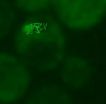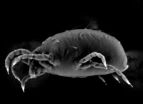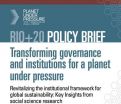(Press-News.org) Kansas City, MO -- The accumulation of damaged protein is a hallmark of aging that not even the humble baker's yeast can escape. Yet, aged yeast cells spawn off youthful daughter cells without any of the telltale protein clumps. Now, researchers at the Stowers Institute for Medical Research may have found an explanation for the observed asymmetrical distribution of damaged proteins between mothers and their youthful daughters.
Reporting in the Nov. 23, 2011, issue of Cell the research team, led by Stowers investigator Rong Li, Ph.D., proposes that the limited mobility of clumps of damaged proteins and yeast cells' geometry -- the narrowness of the connection (bud neck) between the mother and the daughter before their separation, in particular -- are sufficient to ensure that protein aggregates accumulated during the normal aging process are retained in the mother cell during cell division.
"Harmful protein aggregates had recently been thought to be sent back into the mother cell via a directed transport system," says Li. "Our model suggests that no active shuttle mechanism may be necessary to help with the asymmetric segregation of protein aggregates during yeast cell divisions."
In the budding yeast Saccharomyces cerevisae -- an important model organisms used in aging research -- lifespan can be defined by the number of daughter cells a mother has produced, as opposed to by calendar time, a process known as replicative aging. Daughter cells reset their clock and start counting the number of cell division they have undergone from scratch.
VIDEO:
One factor that is known to correlate with replicative age is the buildup of aggregates formed by damaged proteins. To learn more about the movement and fate of damaged proteins...
Click here for more information.
The transition from youth to old age is accompanied by metabolic changes and the accumulation of damage as a result of wear and tear. A central question in aging research is the nature of the damage that contributes to aging and how old mother cells avoid passing on these aging determinants to their daughters.
One factor that is known to correlate with replicative age is the buildup of aggregates formed by damaged proteins. "These proteins are preferentially retained by the mother during bud formation and cell division," explains Li. "A better understanding of replicative aging of a cell population based on asymmetric cell divisions may provide insights into how higher organisms maintain a population of "youthful" stem cells with high proliferative potential during aging."
To learn more about the movement and fate of damaged proteins in dividing yeast cells, graduate student and first author Chuankai Zhou with help from Amr Eldakak, Ph.D, a postdoctoral research associate in the Li laboratory, added a green fluorescent tag to Hsp104p, a protein known to modify and dissolve protein aggregates by unfolding and refolding proteins. Zhou then used live-cell imaging to record the movements of thousands of protein aggregates induced by heat in three dimensions.
"Most movements were confined within the bud or the mother but we did see a few movements from bud to mother and vice versa," says Zhou. "Overall though, we couldn't detect any directionality in the movements of the aggregates." In order to rigorously characterize the movement of the protein aggregates, Zhou collaborated with Stowers Research advisors Brian Slaughter, Ph.D., and Jay Unruh, Ph.D., and used particle tracking and computational analysis to show that the aggregate movement is best described as 'random walk'.
VIDEO:
As yeast cells age they sustain oxidative damage, which results in the accumulation of protein aggregates. These protein clumps follow a random walk pattern but unlike heat shock-induced aggregates don't...
Click here for more information.
Time-lapse movies also revealed that, over time, heat shock-induced aggregates cleared from all buds and their numbers plummeted in mother cells. When Zhou introduced a mutation into Hsp104p that does not affect Hsp104p's ability to bind to protein aggregates but disrupts its refolding activity, aggregates no longer cleared from neither mother nor daughter cell. "It told us that heat-induced aggregates dissolved with the help of Hsp104p," explains Zhou.
Zhou then turned his attention to naturally occurring protein aggregates, which are the result of oxidative damage in cells of older replicative age. He found that these protein clumps followed the same random walk pattern but didn't dissolve over time. However, these aggregates appeared to move within the confines of the mother without escaping into the bud.
With the help of Stowers research advisor Boris Rubinstein, the team used 3D numerical simulations as well as a 1D analytical model to show that the limited, random mobility of the aggregates was sufficient to explain their preferential retention in the mother, and that the narrow opening of the bud neck further helps trapping the aggregates within the mother prior to cell division.
INFORMATION:
The research was supported primarily by a grant from the National Institute of Health.
About the Stowers Institute for Medical Research
The Stowers Institute for Medical Research is a non-profit, basic biomedical research organization dedicated to improving human health by studying the fundamental processes of life. Jim Stowers, founder of American Century Investments, and his wife Virginia opened the Institute in 2000. Since then, the Institute has spent over 800 million dollars in pursuit of its mission.
Currently the Institute is home to over 500 researchers and support personnel; over 20 independent research programs; and more than a dozen technology development and core facilities. Learn more about the Institute at http://www.stowers.org.
How old yeast cells send off their daughter cells without the baggage of old age
2011-11-24
ELSE PRESS RELEASES FROM THIS DATE:
Introducing the monarch butterfly genome
2011-11-24
The Monarch butterfly is famous for its ability to travel up to 2,000 miles from North America to central Mexico every fall. Now, it's enjoying fame of a different sort. In the November 23rd issue of Cell, researchers report the full genomic sequence of this iconic butterfly. The new genome is the first for any butterfly. It is also the first complete genome of any long-distance migrant.
"With this genome sequence in hand, we now have an overwhelming number of opportunities to understand the genetic and molecular basis of long-distance migration," says Steven Reppert ...
Is short stature associated with a 'shortage' of genes?
2011-11-24
New research sifts through the entire genome of thousands of human subjects to look for genetic variation associated with height. The results of the study, published by Cell Press in the December issue of the American Journal of Human Genetics, suggest that uncommon genetic deletions are associated with short stature.
Height is a highly heritable trait that is associated with variation in many different genes. "Despite tremendous recent progress in finding common genetic variants associated with height, thus far these variants only explain about 10% of the variation ...
UMMS scientists present draft sequence of monarch butterfly genome
2011-11-24
WORCESTER, Mass. – Each fall millions of monarch butterflies from across the eastern United States use a time-compensated sun compass to direct their navigation south, traveling up to 2,000 miles to an overwintering site in a specific grove of fir trees in central Mexico. Scientists have long been fascinated by the biological mechanisms that allow successive generations of these delicate creatures to transverse such long distances to a small region roughly 300 square miles in size. To unlock the genetic and regulatory elements important for this remarkable journey, neurobiologists ...
Researchers discover clues to developing more effective antipsychotic drugs
2011-11-24
Researchers from Mount Sinai School of Medicine, have identified the pattern of cell signaling induced by antipsychotic drugs in a complex composed of two brain receptors linked to schizophrenia. The discovery should allow researchers to predict the effectiveness of novel compounds for the treatment of schizophrenia and other serious mental disorders and may accelerate the development of better antipsychotic drugs. The findings are published in the November 23 issue of Cell.
Until now, the molecular mechanism through which current treatments for schizophrenia achieve ...
Big pest, small genome
2011-11-24
SALT LAKE CITY, Nov. 23, 2011 – A University of Utah biologist and an international research team decoded the genetic blueprint of the two-spotted spider mite, raising hope for new ways to attack the major pest, which resists pesticides and destroys crops and ornamental plants worldwide.
The voracious mites, which technically are not insects, can eat more than 1,100 plant species – a rare trait. The mites' newly revealed and sequenced genome contains a variety of genes capable of detoxifying pesticides as well as toxins plants use to defend themselves, the scientists ...
Hours of Service Rules for Commercial Truck Drivers Traveling Through Atlanta
2011-11-24
Almost a year ago, the Federal Motor Carrier Safety Administration (FMCSA) proposed new limits on Hours of Service (HOS) rules for commercial drivers. While the intent was to improve highway safety for all who travel by limiting fatigue among truck drivers, the proposed changes have come under fire from trucking advocacy groups as having little impact on highway safety. The proposed changes in hours of service have not yet been finalized.
Existing Hours of Service Limitations for Commercial Drivers
HOS regulations generally apply to all drivers of commercial vehicles. ...
Supercool
2011-11-24
SALT LAKE CITY -- We drink water, bathe in it and we are made mostly of water, yet the common substance poses major mysteries. Now, University of Utah chemists may have solved one enigma by showing how cold water can get before it absolutely must freeze: 55 degrees below zero Fahrenheit.
That's 87 degrees Fahrenheit colder than what most people consider the freezing point of water, namely, 32 F.
Supercooled liquid water must become ice at minus 55 F not just because of the extreme cold, but because the molecular structure of water changes physically to form tetrahedron ...
Dana-Farber/Children's Hospital Boston study identifies possible therapy for radiation sickness
2011-11-24
BOSTON—A combination of two drugs may alleviate radiation sickness in people who have been exposed to high levels of radiation, even when the therapy is given a day after the exposure occurred, according to a study led by scientists from Dana-Farber Cancer Institute and Children's Hospital Boston.
Mouse studies of other potential therapies suggest they would be effective in humans only if administered within a few minutes or hours of radiation exposure, making them impractical for use in response to events involving mass casualties. In contrast, the larger time window ...
UN overhaul required to govern planet's life support system: Experts
2011-11-24
Reducing the risk of potential global environmental disaster requires a "constitutional moment" comparable in scale and importance to the reform of international governance that followed World War II, say experts preparing the largest scientific conference leading up to next June's Rio+20 Earth Summit.
Stark increases in natural disasters, food and water security problems and biodiversity loss are just part of the evidence that humanity may be crossing planetary boundaries and approaching dangerous tipping points. An effective environmental governance system needs to ...
Disability Insurance Claim Denied? An ERISA Lawsuit Could Help
2011-11-24
Private disability insurance can be a significant source of value for employees and their families, and they expect to be able to rely on it in their times of need. But what happens when an employee's disability insurance claim is denied?
A comprehensive federal law known as the Employee Retirement Income Security Act of 1974, or ERISA, protects the interests of participants in many types of insurance plans. ERISA sets standards for the administration of benefit plans, including the proper procedure for appealing a denial of a claim for benefits. If the claims process ...




